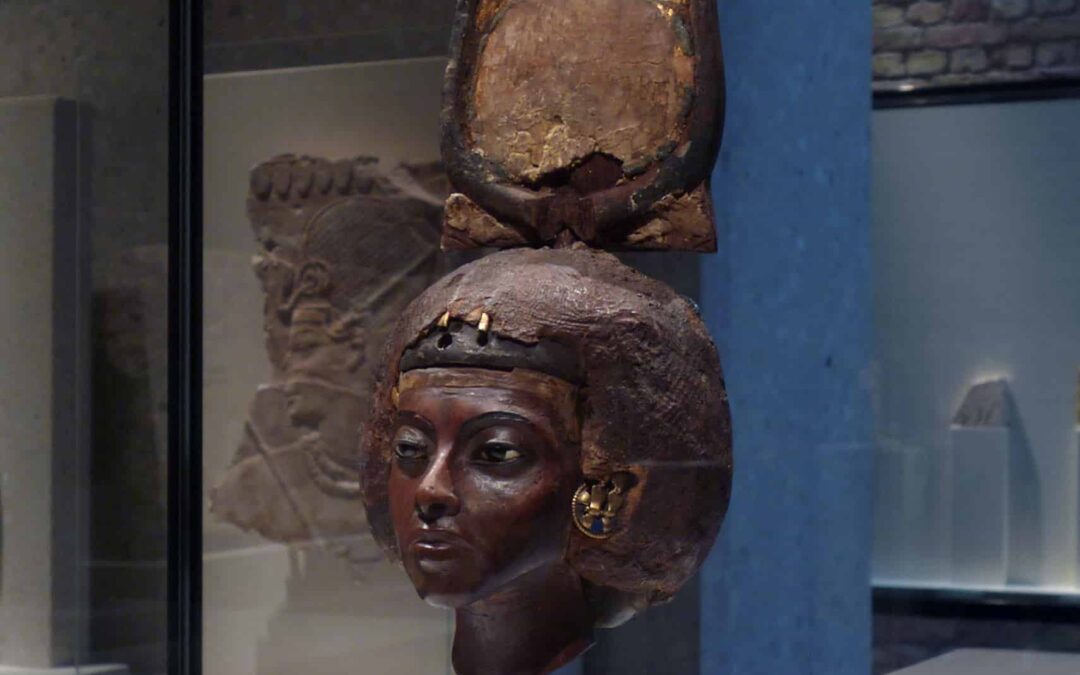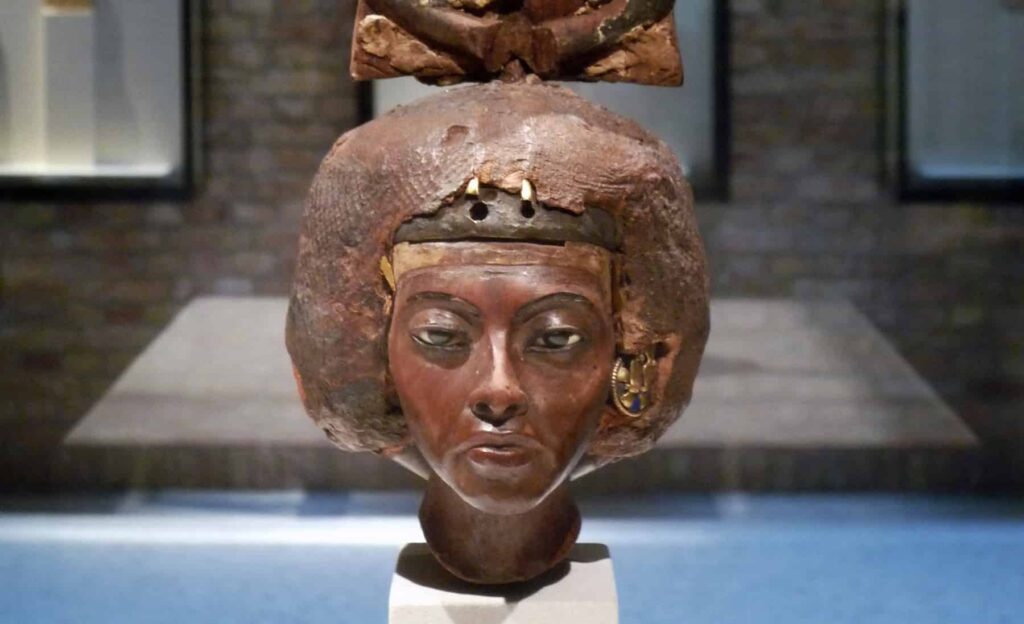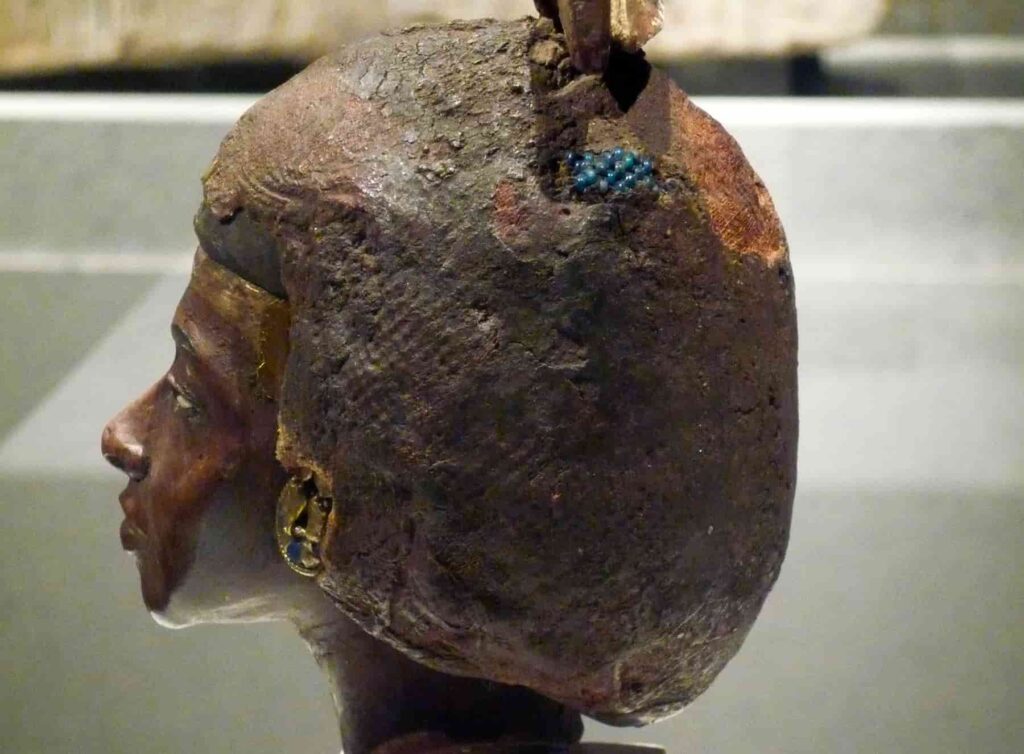
The Head of Queen Tiye is a sculpture dating back to approximately 1355 BC, during the time of the 18th Dynasty of ancient Egypt, and belongs to Egyptian art.
It was discovered at the archaeological site of Gurob, formerly known as Medinet Gurob or Merwer, situated near the villages of Hawara and El Lahun in the El Faiyum region, south of the Nile River delta in Egypt.
Who was Tiye?
Tiye, also known as Tiyi, Taia, Tiya, or Tiy, served as the Great Royal Wife and queen of Pharaoh Amenhotep III during the 18th Dynasty of Egypt.
Despite lacking royal lineage as the daughter of the official Tuya and his wife Thuya, Tiye held significant power. She was prominently featured alongside the pharaoh in various settings, conducted ceremonies, and actively participated in state affairs.Throughout the 39-year reign of Pharaoh Amenhotep III, Tiye emerged as a highly influential woman, wielding considerable authority. She played a crucial role in educating her son, the future pharaoh Akhenaten (also known as Amenhotep IV), and instilled in him the worship of the god Aten, considered the supreme creator.
Description
The sculpture stands at a height of 22.5 cm, with the head measuring 9.5 cm. Crafted from yew wood, gold, silver, and vitreous paste, it is a free-standing representation of Queen Tiye. The sculpture features a rounded female head, reflecting the queen’s likeness.
The head’s distinctive rounded shape is attributed to the wig, known to be composed of layers of linen adhered with gum. In ancient times, the wig was adorned with blue glazed beads, which are unfortunately no longer extant.
At the pinnacle of the head, the Hathoric crown is visible—a tall and stylized crown consisting of cow horns with the solar disk positioned between them, along with two prominent feathers.
In ancient Egypt, the Hathoric crown was exclusively reserved for the Great Royal Wives, symbolizing their divinization and elevated status within the clergy. These queens played a leading role in ceremonies and rituals, further emphasizing their significance in the religious and political realms of ancient Egyptian society.
It’s worth noting that, at the time of its discovery, the crown and the head, although found in the same location, were separate.
Researchers observed that the crown had appropriate dimensions and could be fitted onto the connecting spike at the top of the head.
The face features almond-shaped eyes with prominent and bulging eyelids. Dark bags under the eyes are also noticeable.
The eyebrows, outlined and extending toward the temples, exhibit a wrinkle mark near them.
The effect of the slanted look is evident in the eyes, along with the dark bags and eyelids.
When viewed in profile, the nose appears narrow and elongated.
The full lips are clearly outlined, and sinuous lines mark the shape of the cheekbones.
Notably, the right ear boasts a circular gold earring with a dark blue inlay.
The earring is visible due to a fracture in the wig, indicating potential modifications to conceal the original jewelry. This information comes from radiographic studies and scanner examinations conducted by researchers.
These studies also unveil the presence of a similar earring under the wig in the left ear. Additionally, a silver khat headdress, adorned with two cobras atop the queen’s forehead, was discovered beneath the wig.
Regarding composition, the sculpture stands out for the expressiveness and naturalism depicted in the facial features.
The entire sculpture captures the queen’s age, evident in the flaccidity and pronounced wrinkles around the nose and mouth corners.
Finally, it’s important to highlight that the entire sculpture is crafted from orange-colored yew wood, although over time, the color has darkened.
Currently, the sculpture is housed in the Egyptian Museum in Berlin, Germany.



News
Unveiling the Ingenious Engineering of the Inca Civilization: The Mystery of the Drill Holes at the Door of the Moon Temple in Qorikancha – How Were They Made? What Tools Were Used? What Secrets Do They Hold About Inca Technology? And What Does Their Discovery Mean for Our Understanding of Ancient Construction Methods?
In the heart of Cusco, Peru, nestled within the ancient Qorikancha complex, lies a fascinating testament to the advanced engineering prowess of the Inca civilization. Here, archaeologists have uncovered meticulously angled drill holes adorning the stone walls of the Door…
Unveiling the Sun Stone: Aztec Relic from the Reign of Moctezuma II (1502-1520) – What Secrets Does It Hold? How Was It Used? What Symbolism Does It Carry? And What Does Its Discovery Reveal About Aztec Culture?
In the heart of Mexico City, amidst the bustling Plaza Mayor, lies a silent sentinel of ancient wisdom and artistry – the Sun Stone. This awe-inspiring artifact, dating back to the reign of Moctezuma II in the early 16th century,…
Uncovering the Past: Rare 1,000-Year-Old Copper Arrowhead Found – Who Crafted It? What Was Its Purpose? How Did It End Up Preserved for So Long? And What Insights Does It Offer into Ancient Societies?
In the realm of archaeology, every discovery has the potential to shed light on our shared human history. Recently, a remarkable find has captured the attention of researchers and enthusiasts alike – a rare, 1,000-year-old copper arrowhead. This ancient artifact…
Unveiling History: The Discovery of an Old Sword in Wisła, Poland – What Secrets Does It Hold? Who Owned It? How Did It End Up There? And What Does Its Discovery Mean for Our Understanding of the Past?
In a remarkable archaeological find that has captured the imagination of historians and enthusiasts alike, an old sword dating back to the 9th-10th century AD has been unearthed in Wisła (Vistula River) near Włocławek, Poland. This discovery sheds light on the rich…
Unveiling the Hidden Riches: Discovering the Treasure Trove of a Notorious Pirate – Who Was the Pirate? Where Was the Treasure Found? What Historical Insights Does It Reveal? And What Challenges Await Those Who Seek to Uncover Its Secrets?
A group of divers said on May 7 that they had found the treasure of the infamous Scottish pirate William Kidd off the coast of Madagascar. Diver Barry Clifford and his team from Massachusetts – USA went to Madagascar and…
Excavation Update: Archaeologists Unearth Massive Cache of Unopened Sarcophagi Dating Back 2,500 Years at Saqqara – What Secrets Do These Ancient Tombs Hold? How Will They Shed Light on Ancient Egyptian Burial Practices? What Mysteries Await Inside? And Why Were They Buried Untouched for Millennia?
Egypt has unearthed another trove of ancient coffins in the vast Saqqara necropolis south of Cairo, announcing the discovery of more than 80 sarcophagi. The Tourism and Antiquities Ministry said in a statement that archaeologists had found the collection of colourful, sealed caskets which were…
End of content
No more pages to load











